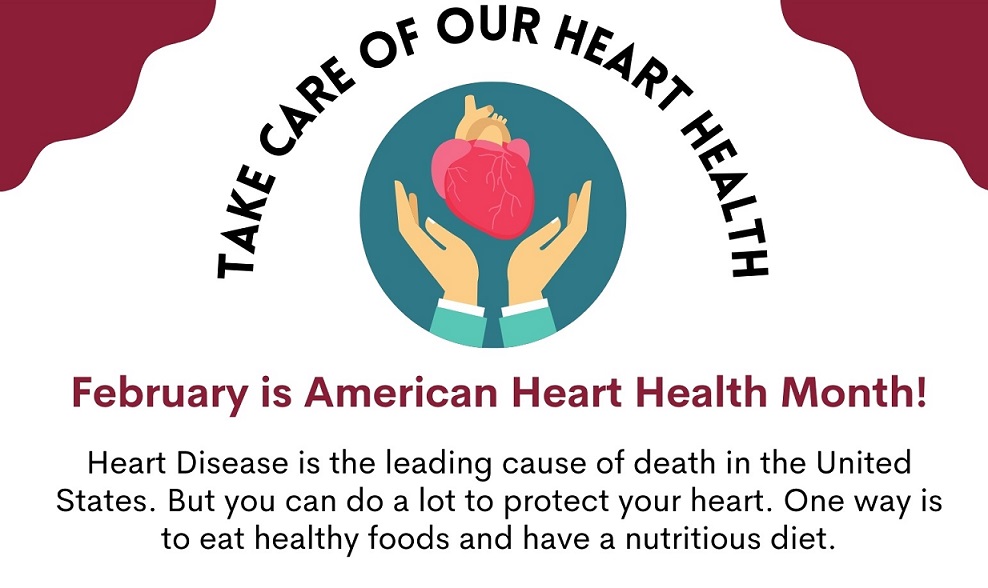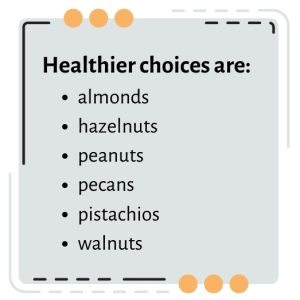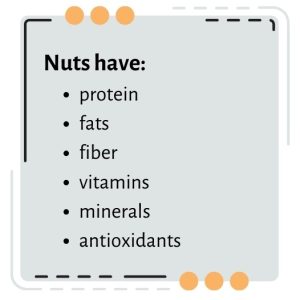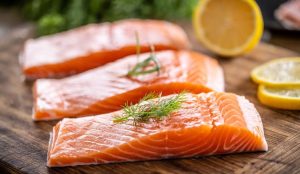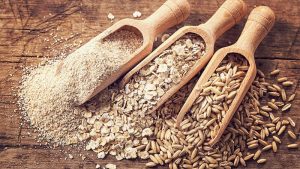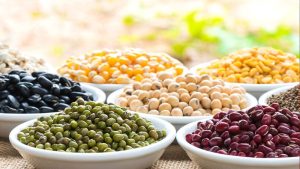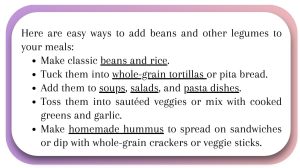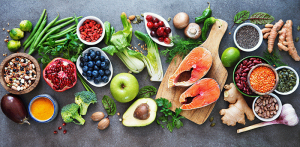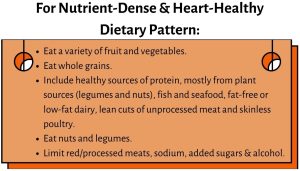Your heart is the center of your health and vitality, pumping blood throughout your body to supply your organs and tissues with essential nutrients and oxygen. So, it makes sense that if you follow a heart-healthy diet, it can help your cardiovascular health and everything else that your heart affects.
Tomah Health’s Cardiac & Pulmonary Rehabilitation Team & Registered Dietitian Nutritionist Michelle Lindsay, MS, RDN, CD, have teamed up this February during American Heart Health Month to provide essential information on how to incorporate heart-healthy options into your diet.
Why eat heart-healthy options?
Eating too much food high in saturated fats or simple sugars can lead to heart disease. But eating certain foods can lower your risk. A “heart-healthy” diet limits the amount of foods that put you at risk for heart disease and allows you to eat plenty of the foods that keep your heart healthy.
A heart-healthy diet should lower the “bad” cholesterol (called LDL) and triglycerides in your blood and help raise your “good” cholesterol (called HDL). It will also help you control your weight and may lower your risk of cancer.
Choosing Heart-Healthy Foods:
Heart-healthy eating involves choosing certain foods, such as fruits and vegetables, while limiting others, such as saturated fats and added sugars. This month we are highlighting these foods that can improve your heart health:
Crunchy nuts are petite powerhouses of taste and nutrition. They’re portable and delicious, both whole and in nut butter form, spread on apple slices, celery sticks, and bananas.
Walnuts are especially high in omega-3 fatty acids, similar to the heart-healthy fat found in oily fish, but they are a lot easier to stash in your pocket or purse.
A serving size is a small handful or 1.5 ounces of whole nuts or two tablespoons of nut butter. Compare nutrition labels and choose nut kinds of butter with the lowest amounts of sodium, preferably no added tropical oils (palm, coconut) or sugars.
All nuts will go bad (rancid) in time, so keep them in the fridge. The same goes for nut oils and nut kinds of butter in jars after you’ve opened them. Rancid nuts have an unpleasant smell and bitter taste. If you’re using nuts in a recipe, taste one to ensure it’s still fresh, or you could ruin the whole dish.
Fish is a good source of protein and, unlike fatty meat products, it’s not high in saturated fat. Regularly eating fish and seafood is consistently associated with a lower risk for cardiovascular disease. Fatty fish is also a good source of omega-3 fatty acids, which are good for your heart. Research has shown that omega-3 fatty acids can reduce your risk of heart disease and stroke.
The American Heart Association recommends a dietary pattern that includes healthy sources of proteins, mostly from plant sources; regularly eating fish and seafood; substituting nonfat and low-fat dairy products in place of full-fat versions; and for people who eat meat or poultry, choosing those that are lean and unprocessed. They recommend eating two servings of fish (particularly fatty fish) weekly.
A serving is 3 ounces cooked or about ¾ cup of flaked fish. Fatty fish like anchovies, herring, mackerel, black cod, salmon, sardines, bluefin tuna, whitefish, striped bass, and cobia are high in omega-3 fatty acids.
Is fish good for women who are pregnant, have babies, and have young children?
Fish consumption as part of a heart-healthy dietary pattern is healthy for moms and their babies. Some types of fish contain high levels of mercury or other environmental contaminants. Pregnant women planning to become pregnant or nursing, as well as parents or others feeding young children, should check this U.S. Food and Drug Administration (FDA) website for the latest advisories to avoid eating contaminated fish.
Eating a variety of fish will help minimize any potentially adverse effects due to environmental pollutants. The benefits far outweigh the potential risks when the amount of fish eaten is within the recommendations established by the FDA and Environmental Protection Agency.
By now, you’ve probably heard eating more fiber-rich whole grains is a good idea. The American Heart Association recommends eating three or more servings of fiber-rich whole grains every day.
While you may be familiar with brown rice and 100% whole wheat bread, there are lots of other tasty whole grain options. And most are money savers, especially when you buy them in bulk. Here’s how to expand your whole-grain horizons:
Whole Grain: Barley
- Description: Barley is high in fiber. It has a chewy texture and nutty taste, like brown rice. Barley is also found in packaged granolas, hot cereals, and soup mixes. Hulled barley has the most fiber because its bran layer is not removed and takes the longest to cook.
- Common Sources: Hulled or hull-less barley or whole-grain barley
- Cooking Tips: Bring 3 cups of water to a boil. Add 1 cup of hulled barley, cover, and turn the heat to medium-low. Cook for 40- 45 minutes. Cooked barley adds bulk and flavor to soups, casseroles, and cooked vegetables – just about any recipe that calls for rice can be replaced with barley. Toss cooked barley with your favorite cooked beans, chopped onions, and fresh herbs for a twist on plain rice & beans.
Whole Grain: Bulgur
- Description: Bulgur is made from wheat kernels that have been dried and boiled, it’s usually sold as fine or coarse. Sometimes bulgur is confused with cracked wheat, which isn’t previously boiled, so it needs to be cooked longer than bulgur.
- Common Sources: Bulgur wheat
- Cooking Tips: Soak 1 cup bulgur in 1 ½ cups very hot water, and it’s ready in 15 minutes! Bulgur can be added to soups, meatballs, and meatloaf or substituted for rice in cold and hot dishes. To make tabbouleh, a popular Middle Eastern grain salad, mix cooked bulgur with chopped parsley, mint, tomatoes, lemon juice, and a drizzle of olive oil.
Whole Grain: Corn
- Description: Surprise! Corn is a whole grain available in many forms and is inexpensive, too. When buying corn products (flour, meal, grits) other than kernels, look for the words “whole grain corn” in the ingredient list.
- Common Sources: Whole kernels (fresh, frozen, canned), popcorn, whole cornmeal, whole grits, corn tortillas (made with whole-grain corn or whole cornmeal)
- Cooking Tips: To cook cornmeal (polenta), mix 1 cup whole cornmeal with 1 cup cool water. Bring 3 cups water to a boil, and slowly whisk in the cornmeal mixture. Reduce heat and cook for 10 -15 minutes, stirring often. Use whole cornmeal to make muffins, cornbread, or pancakes. Add fresh or frozen kernels to salads, soups, and casseroles. Down South, grits are eaten at breakfast, lunch, and dinner, served with black pepper or a drizzle of honey.
Whole Grain: Millet
- Description: Millet is more often found in birdseed than on our tables! When cooked, the tiny yellow balls fluff ups like rice. Millet has a delicious, nutty flavor.
- Common Sources: Hulled millet or whole millet
- Cooking Tips: Bring 2 ½ cups of water to a boil; add 1 cup of millet. Lower heat, cover, and cook for 20 – 25 minutes. After cooking, whip millet just like you would to make mashed potatoes! For extra flavor, toast millet in a pan for 10 minutes before cooking. Add ½ a cup to batter for banana bread or corn muffins for an added crunch.
Whole Grain: Oats
- Description: Oats are one of the most popular whole grains in America. Choose steel-cut or old-fashioned oats more often – they are affordable, and the plain bulk versions have no sodium, sugar, or preservatives compared to some flavored oatmeal products.
- Common Sources: Steel cut oats, old fashioned/rolled oats, quick or instant oats, whole oat flour
- Cooking Tips: Bring 2 cups water and 1 cup old-fashioned oats to a boil. Lower to medium heat and cook for 8 – 10 minutes until creamy, stirring frequently. Cook your oatmeal in low-fat milk for a creamier taste and extra nutrients. Mix in dried fruit and nuts for a filling breakfast.
Whole Grain: Quinoa
- Description: Quinoa is a South American grain. It has a slightly crunchy texture and is rising in popularity in the U.S. Quinoa is also used to make some brands of gluten-free pasta.
- Common Sources: Whole grain quinoa, whole quinoa Flakes, Whole quinoa flour
- Cooking Tips: Always rinse quinoa before cooking to prevent it from tasting bitter. Bring 2 cups of water to a boil; add 1 cup quinoa. Reduce heat, cover, and cook for about 20 minutes. Use in salads, casseroles, hot breakfast cereals, and bean dishes for a boost of nutrition and a nutty crunch.
Every plant we eat has at least a small amount of protein in it, and some have a lot — like beans, which are part of the family of legumes.
Plant-based proteins such as beans and other legumes are high in minerals and dietary fiber without the saturated fat and cholesterol in some animal proteins. The American Heart Association recommends beans and other legumes as part of a healthy eating pattern.
Substituting plant-based proteins for red meat can lower blood cholesterol, a risk factor for heart disease. Adding beans and other legumes to your diet may also help you feel full longer because of the high dietary fiber content.
The wide varieties of beans include black, kidney, garbanzo, pinto, cannellini, lima, mung, and navy, as well as other legumes, such as black-eyed peas and lentils. Choose the no-salt-added or low-sodium options if you use canned beans or other legumes. Drain and rinse canned beans in a colander to help remove excess sodium. Consider using dried beans to make your salt-free beans.
What Does Nutrient Dense Mean?
Nutrient-dense foods are rich in vitamins, minerals, and other nutrients important to our health. They also don’t have too much saturated fat, added sugars, and/or sodium. Nutrient density is the amount of nutrients you get for the calories consumed. Research suggests that the standard American diet is energy-rich and nutrient-poor. When we say energy, we mean calories. “Empty calories” are in foods that provide a lot of calories without much nutritional value.
One of the tools you can use to choose more nutrient-dense foods is the American Heart Association’s Heart-Check Mark. When you see the mark, you can be confident the product aligns with our recommendations for an overall healthy eating pattern.
The Heart-Check mark considers beneficial nutrients as well as nutrients you should limit, making it quick and easy for you to make a healthy choice.
When a Heart-Check certified option isn’t available, read and compare Nutrition Facts labels and choose the best option. For example: Let’s say you’re looking at the Nutrition Facts labels of two packages of bread to decide which one is the healthier choice. The white bread has about 80 calories per slice, but few vitamins and minerals. The whole-grain version has about the same number of calories, but more protein, three times the magnesium, and more than double the fiber, potassium, vitamin B6, and zinc. The nutrition information shows that the whole-grain option is the more nutrient-dense choice.
How to Add Nutrient-Dense Foods to Your Healthy Eating Plan
Sometimes it only takes a small shift to make a more nutrient-dense choice. Here’s how you can get started:
- Switch from white bread, rice, and pasta to whole-grain pasta, whole-wheat bread, and brown rice.
- Instead of a dollop of full-fat sour cream on your chili or baked potato, try fat-free or low-fat plain Greek yogurt.
- When adding toppings to pizza, stuffing tacos, or piling up sandwiches, add veggies instead of extra meat or cheese.
By making some simple swaps in your favorite recipes, you can easily boost the nutrient density of your family’s meals and snacks.
What about snacks?
Most of us, including kids and adolescents, get a significant portion of our daily energy (calories) from snacks. Traditional snack foods, such as chips, cookies, and crackers, and drinks, such as sodas and sports drinks, can be high in calories, saturated fat, sodium, and/or added sugars but low in nutrient density.
When snacking, choose mostly nutrient-dense foods, such as fat-free or low-fat dairy products as well as a variety of fruits, vegetables, and nuts.
- Snack on crunchy vegetables with a fat-free or low-fat yogurt-based dip.
- Eat a handful of unsalted nuts instead of chips.
- Satisfy a sweet tooth with naturally sweet fruit on its own or in a smoothie instead of candy and cookies.
- Replace sugary drinks with water infused with fruit and/or herbs, or unsweetened tea or coffee.
The Takeaways
- Choose more nutrient-dense foods to get the beneficial nutrients your body needs without consuming too many calories.
- Focus on your overall eating pattern, rather than individual nutrients or specific foods or food groups.
Healthy eating starts with healthy food choices. You don’t need to be a chef to create nutritious, heart-healthy meals your family will love. Enjoy these delicious heart-healthy options that are being featured this February.
-
Pecan Crusted Walleye with Dijon Cream Sauce
-
Honey Mustard Pecan Crusted Salmon
-
Mushroom & Barley Soup
-
Sweet Potato & Black Bean Chili
-
Roasted Root Vegetables
